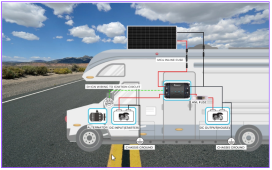Mash
New Member
- Joined
- Dec 2, 2022
- Messages
- 28
First off, I apologize for putting up duplicate info as I continue to get confused and educated by looking everyone else's diagrams.
I have a 2003 Winnebago Minnie and am wanting to get it ready to be able to be able to boondock for short periods of time. Like a week or so. I don't plan on becoming a full timer but will want to be able to work remotely, so I will need to power a laptop, wifi router, Weboost, TV, Fridge running in propane mode, and fans. Going to swap the FLA batteries with Lithium and move them to a storage compartment just next to the existing open air battery compartment.
I have some equipment already that I have been gathering with is what it is, I am sure not the best in the world but I didn't know better. I have in boxes: an upgraded converter/charger for the RV that supports Lithium batteries, 2 x 100 ah LiTime 12v LiPo batteries, Renogy DCC30S (DC-DC w/MPPT) charger, and a 1000W pure sine inverter.
I would love feedback and hope to get to the install next month.



I have a 2003 Winnebago Minnie and am wanting to get it ready to be able to be able to boondock for short periods of time. Like a week or so. I don't plan on becoming a full timer but will want to be able to work remotely, so I will need to power a laptop, wifi router, Weboost, TV, Fridge running in propane mode, and fans. Going to swap the FLA batteries with Lithium and move them to a storage compartment just next to the existing open air battery compartment.
I have some equipment already that I have been gathering with is what it is, I am sure not the best in the world but I didn't know better. I have in boxes: an upgraded converter/charger for the RV that supports Lithium batteries, 2 x 100 ah LiTime 12v LiPo batteries, Renogy DCC30S (DC-DC w/MPPT) charger, and a 1000W pure sine inverter.
I would love feedback and hope to get to the install next month.





